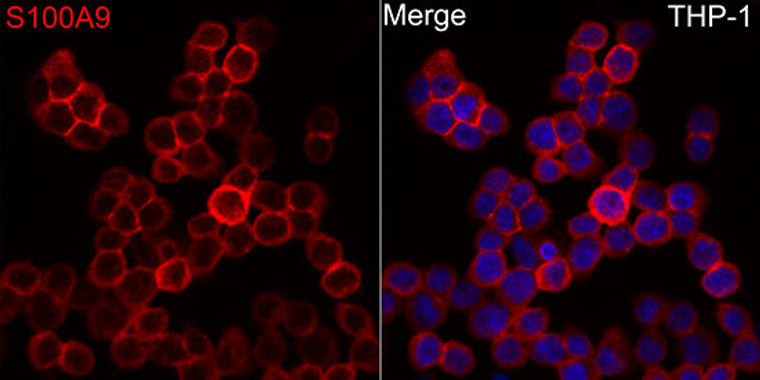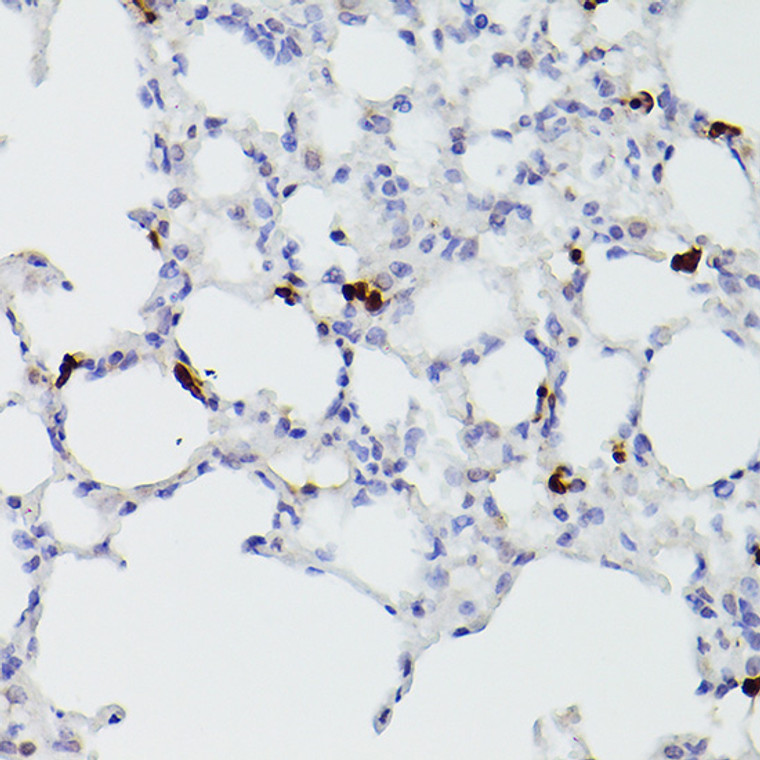| Tissue Specificity | Calprotectin (S100A8/9) is predominantly expressed in myeloid cells. Except for inflammatory conditions, the expression is restricted to a specific stage of myeloid differentiation since both proteins are expressed in circulating neutrophils and monocytes but are absent in normal tissue macrophages and lymphocytes. Under chronic inflammatory conditions, such as psoriasis and malignant disorders, also expressed in the epidermis. Found in high concentrations at local sites of inflammation or in the serum of patients with inflammatory diseases such as rheumatoid, cystic fibrosis, inflammatory bowel disease, Crohn's disease, giant cell arteritis, cystic fibrosis, Sjogren's syndrome, systemic lupus erythematosus, and progressive systemic sclerosis. Involved in the formation and deposition of amyloids in the aging prostate known as corpora amylacea inclusions. Strongly up-regulated in many tumors, including gastric, esophageal, colon, pancreatic, bladder, ovarian, thyroid, breast and skin cancers. |
| Post Translational Modifications | Phosphorylated. Phosphorylation inhibits activation of tubulin polymerization. S-nitrosylation of Cys-3 is implicated in LDL(ox)-induced S-nitrosylation of GAPDH at 'Cys-247' through a transnitrosylase mechanism involving a iNOS-S100A8/9 complex. Methylation at His-105 by METTL9 reduces zinc-binding without affecting heterodimerization with S100A8. |
| Function | S100A9 is a calcium- and zinc-binding protein which plays a prominent role in the regulation of inflammatory processes and immune response. It can induce neutrophil chemotaxis, adhesion, can increase the bactericidal activity of neutrophils by promoting phagocytosis via activation of SYK, PI3K/AKT, and ERK1/2 and can induce degranulation of neutrophils by a MAPK-dependent mechanism. Predominantly found as calprotectin (S100A8/A9) which has a wide plethora of intra- and extracellular functions. The intracellular functions include: facilitating leukocyte arachidonic acid trafficking and metabolism, modulation of the tubulin-dependent cytoskeleton during migration of phagocytes and activation of the neutrophilic NADPH-oxidase. Activates NADPH-oxidase by facilitating the enzyme complex assembly at the cell membrane, transferring arachidonic acid, an essential cofactor, to the enzyme complex and S100A8 contributes to the enzyme assembly by directly binding to NCF2/P67PHOX. The extracellular functions involve pro-inflammatory, antimicrobial, oxidant-scavenging and apoptosis-inducing activities. Its pro-inflammatory activity includes recruitment of leukocytes, promotion of cytokine and chemokine production, and regulation of leukocyte adhesion and migration. Acts as an alarmin or a danger associated molecular pattern (DAMP) molecule and stimulates innate immune cells via binding to pattern recognition receptors such as Toll-like receptor 4 (TLR4) and receptor for advanced glycation endproducts (AGER). Binding to TLR4 and AGER activates the MAP-kinase and NF-kappa-B signaling pathways resulting in the amplification of the pro-inflammatory cascade. Has antimicrobial activity towards bacteria and fungi and exerts its antimicrobial activity probably via chelation of Zn(2+) which is essential for microbial growth. Can induce cell death via autophagy and apoptosis and this occurs through the cross-talk of mitochondria and lysosomes via reactive oxygen species (ROS) and the process involves BNIP3. Can regulate neutrophil number and apoptosis by an anti-apoptotic effect.regulates cell survival via ITGAM/ITGB and TLR4 and a signaling mechanism involving MEK-ERK. Its role as an oxidant scavenger has a protective role in preventing exaggerated tissue damage by scavenging oxidants. Can act as a potent amplifier of inflammation in autoimmunity as well as in cancer development and tumor spread. Has transnitrosylase activity.in oxidatively-modified low-densitity lipoprotein (LDL(ox))-induced S-nitrosylation of GAPDH on 'Cys-247' proposed to transfer the NO moiety from NOS2/iNOS to GAPDH via its own S-nitrosylated Cys-3. The iNOS-S100A8/A9 transnitrosylase complex is proposed to also direct selective inflammatory stimulus-dependent S-nitrosylation of multiple targets such as ANXA5, EZR, MSN and VIM by recognizing a IL-x-C-x-x-DE motif. |
| Protein Name | Protein S100-A9Calgranulin-BCalprotectin L1h SubunitLeukocyte L1 Complex Heavy ChainMigration Inhibitory Factor-Related Protein 14Mrp-14P14S100 Calcium-Binding Protein A9 |
| Database Links | Reactome: R-HSA-1236974Reactome: R-HSA-166058Reactome: R-HSA-5602498Reactome: R-HSA-5603041Reactome: R-HSA-5668599Reactome: R-HSA-5686938Reactome: R-HSA-6798695Reactome: R-HSA-6799990 |
| Cellular Localisation | SecretedCytoplasmCytoskeletonCell MembranePeripheral Membrane ProteinPredominantly Localized In The CytoplasmUpon Elevation Of The Intracellular Calcium LevelTranslocated From The Cytoplasm To The Cytoskeleton And The Cell MembraneUpon Neutrophil Activation Or Endothelial Adhesion Of MonocytesIs Secreted Via A Microtubule-MediatedAlternative Pathway |
| Alternative Antibody Names | Anti-Protein S100-A9 antibodyAnti-Calgranulin-B antibodyAnti-Calprotectin L1h Subunit antibodyAnti-Leukocyte L1 Complex Heavy Chain antibodyAnti-Migration Inhibitory Factor-Related Protein 14 antibodyAnti-Mrp-14 antibodyAnti-P14 antibodyAnti-S100 Calcium-Binding Protein A9 antibodyAnti-S100A9 antibodyAnti-CAGB antibodyAnti-CFAG antibodyAnti-MRP14 antibody |


















